MXA RACE TEST: 2025 YAMAHA’S LEGACY TWO-STROKES: 2025 YZ125 & YZ250
Even though the 1974 Yamaha YZ125 and YZ250 models weren’t blue, they are still part of an enviable record as the longest-running dirt bike models made. However, Yamaha’s entrance into motocross didn’t actually begin in 1974; it kicked off in 1968 with the DT-1 250 (when outfitted with the GYT kit).
Paradoxically, Yamaha was also a pioneer in the resurgence of four-stroke race bikes with the all-blue 1998 YZ400F. The success of the 1998 Yamaha YZ400F kick-started the four-stroke movement, but also spelled the beginning of the end for a large number of production two-strokes.
Strangely, it was Yamaha who lobbied for the AMA to rewrite the “works bike” section of the rulebook, which in 1985 had banned factory works bikes from AMA races. In 1997, at Yamaha’s request, the AMA introduced the “four-stroke exemption” rule that allowed every manufacturer the right to race a full works four-stroke for one year before it had to be homologated and made available to the public.
KTM jumped into action first, using the rule for its 540SX in 1997. Lance Smail was the first rider to make a Supercross main event on a four-stroke at Daytona in 1997, but it was Yamaha and Doug Henry who spearheaded the four-stroke revolution when Doug won the Las Vegas Supercross later in 1997 on the YZM400F, and then ran away with the 1998 250 National Championship on the 1998 Yamaha YZ400 four-stroke.
Even though Yamaha pioneered the return of the four-stroke to the AMA ranks, they never gave up on the two-stroke and have benefited greatly from keeping their two-stroke fires burning. Today, only Yamaha and the KTM Group still make competitive motocross two-strokes. Honda discontinued its two-stroke lineup in 2007. Suzuki’s last run of the RM125 and RM250 two-strokes came down the line in 2008, and Kawasaki’s final run of 250 two-strokes petered out in 2007, leaving Yamaha as the only Japanese brand to continue to build two-stroke motocross bikes.
EVEN WITH VERY FEW UPDATES OVER THE YEARS, YAMAHA STAYED RELEVANT IN THE TWO-STROKE WORLD THROUGH THE PROCESS OF ELIMINATION. AFTER 2008, YAMAHA BECAME THE ONLY JAPANESE MANUFACTURER SELLING TWO-STROKES.
Even with very few updates over the years, Yamaha stayed relevant in the two-stroke world through the process of elimination. After 2008, Yamaha became the only Japanese manufacturer selling two-strokes, meaning that any Honda, Kawasaki or Suzuki loyalist who wanted a two-stroke had to buy it from Yamaha or KTM. Obviously, Yamaha had the edge in converting former Suzuki, Kawasaki or Honda two-stroke owners to Yamahas instead of to Austrian bikes.
However, as the Japanese brands fell asleep at the wheel, KTM quietly built an arsenal of competitive two-stroke machines for motocross, enduro and cross-county racing. In the interim Yamaha lost its original advantage over KTM when the blue crew fell behind, first in off-road two-strokes and eventually in motocross models. KTM kept innovating, updating and refining its two-stroke technology, while Yamaha sat on its same-old 2006 tech.
When KTM bought Husqvarna in 2013 and GasGas in 2021, they added both Husqvarna and GasGas two-strokes to their model lines. And by 2025, the Austrian group was manufacturing 23 different two-stroke models. Yamaha only offers four full-size two-strokes—the YZ125, YZ125X, YZ250 and YZ250X.
For quite a while, the MXA test riders were critical of Yamaha’s two-bike, two-stroke motocross line, especially since the YZs had changed very little since their inception. The most noteworthy updates were the aluminum frames in 2005 and Kayaba SSS forks in 2006. MXA has always praised Kayaba for their amazing forks, but Yamaha’s benign neglect allowed KTM to catch and pass them in both the 125 and 250 performance rankings—and on the sales charts.
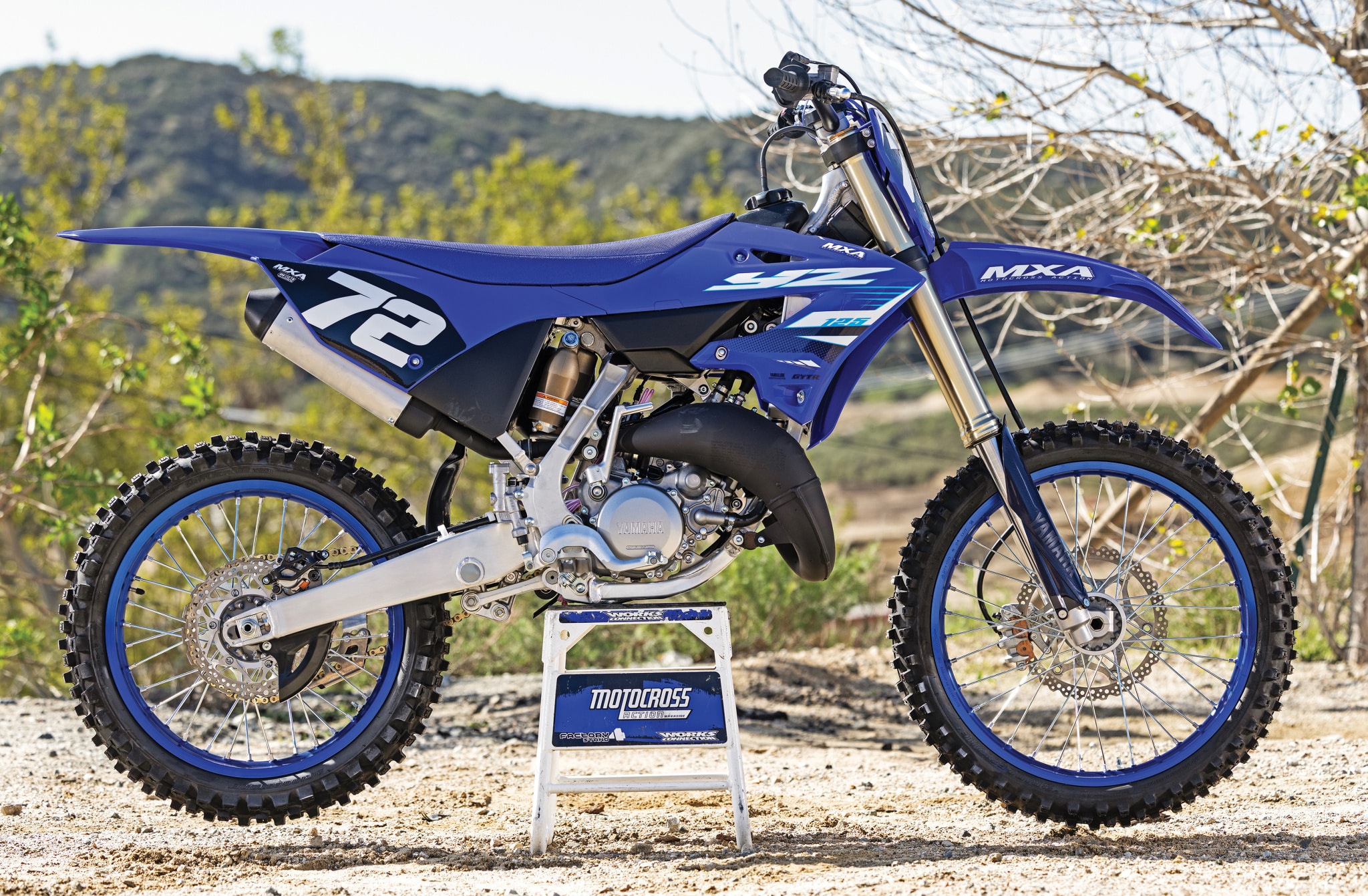 The 2025 Yamaha YZ125’s biggest flaw is that it’s not the fastest 125 on the track. Yes, you can spend money to beef up the YZ125 engine, but the KTM, Husky and GasGas riders can do the same to stay ahead.
The 2025 Yamaha YZ125’s biggest flaw is that it’s not the fastest 125 on the track. Yes, you can spend money to beef up the YZ125 engine, but the KTM, Husky and GasGas riders can do the same to stay ahead.
It wasn’t until 2022 that the unthinkable happened: Yamaha came out with a new YZ125 engine. From the outside, it was hard to tell what Yamaha did to the YZ125 engine; however, it was new inside and out and remains the same for 2025.
(1) The combustion chamber’s height was increased by 1.6mm. The chamber volume was enlarged by 2.4 percent, and the compression ratio dropped from 8.57 to 8.20.
(2) The piston gained a new skirt shape to match the ports. The piston’s rigidity was increased while it also gained a stronger piston pin.
(3) Dowel pins were added to the cylinder head to align it with the cylinder’s bore. The cylinder’s base was increased in size, and the front studs were moved 3mm forward to make more room for a larger exhaust port and bigger, lower and wider transfer ports. The intake port is larger, and the power valve has an updated shape, lift and timing.
(4) The intake angle on the crankcase was increased by 4 percent, and the crankcase was made 8mm taller at the cylinder junction.
(5) The exhaust pipe got a narrower profile, and the silencer was made 2 inches shorter.
(6) There was an 8mm-longer connecting rod, and the rotational inertia of the crank was increased by 2.70 percent, while the flywheel gained a 21-percent increase in rotational inertia to improve the mid- to high-rpm power.
(7) Plus, to feed the new engine, they added a Keihin PWK-S38 PowerJet carburetor.
(8) Besides the changes to the engine, there were also updates to the YZ125 chassis, such as a taller and flatter seat (replacing the banana-style seat that dipped low in the middle). It gained a new fuel tank, which helped to make the bike 36mm skinnier at the tip of the shrouds and 7mm narrower in the middle where your knees grip. There was a new subframe, new side number plates, a new seat base and new air-filter cage, all to flow more air into the engine. The YZ models were graced with the same Nissin brakes as on the Yamaha four-strokes, plus a new chain, rear sprocket and stiffer suspension settings.
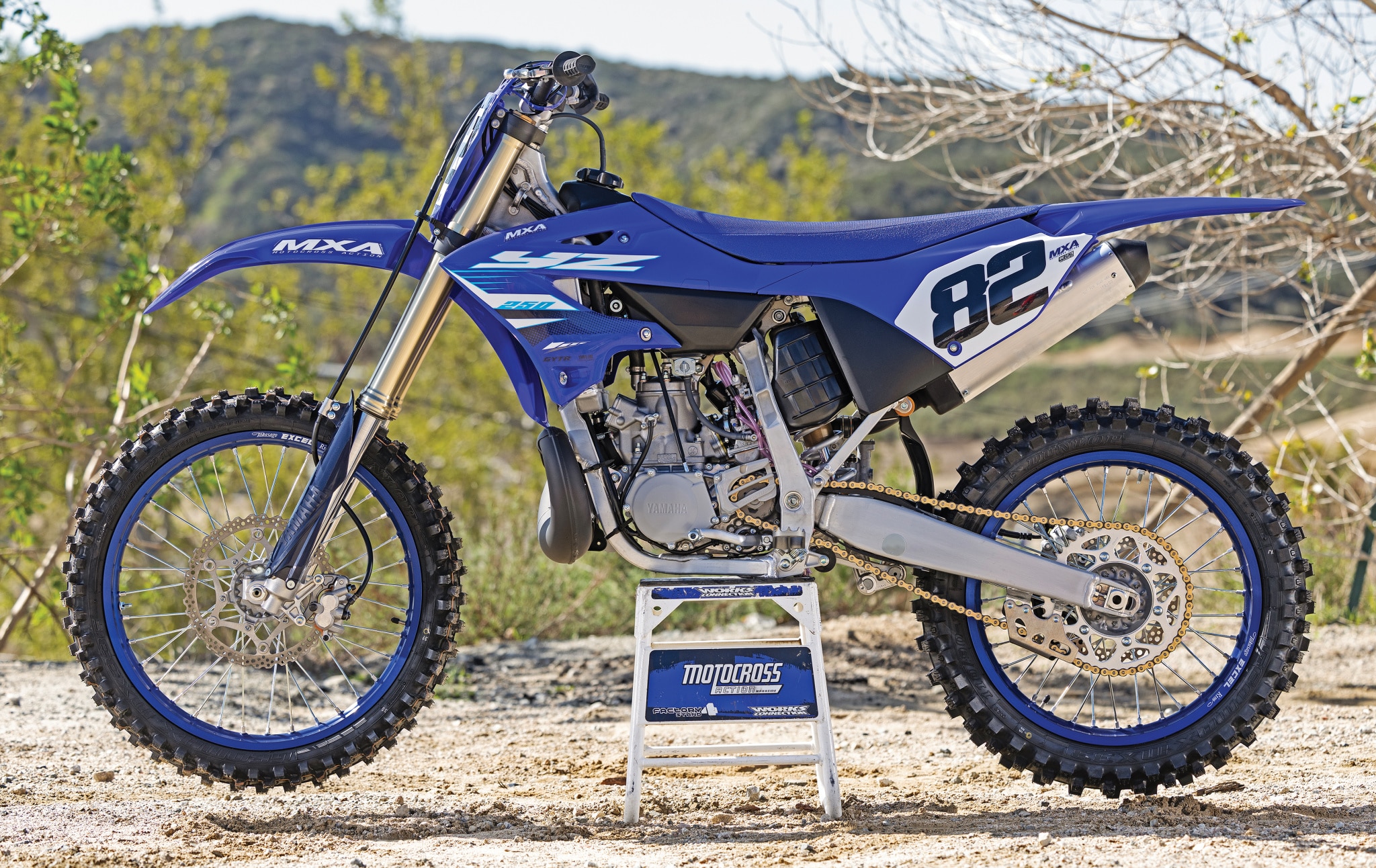 In 2022 the YZ250 got modernized bodywork, but it kept the same bones (chassis) and the same heart (engine) that it had since 2006.
In 2022 the YZ250 got modernized bodywork, but it kept the same bones (chassis) and the same heart (engine) that it had since 2006.
But there was trouble in River City. Initially, MXA was blown away that Yamaha had spent real R&D dollars on updating the 125cc two-stroke. We expected the first all-new YZ125 in 16 years to be a KTM killer. Unfortunately, the engine fell far short of KTM in all aspects of the power curve. Sadly, the new engine wasn’t even impressive when compared to the 2021 YZ125 engine. It took Yamaha 16 years to update the YZ125 engine, and the result was that it was slightly slower on the bottom end and slightly stronger on the top end—1.03 horsepower to be exact. We had higher hopes for the first totally new Yamaha YZ125.
As for the 2022 Yamaha YZ250, it was also updated, but not as much as the YZ125. It kept the same engine but gained a new subframe, skinnier fuel tank, taller and flatter seat to go with the new bodywork, and an opened-up intake tract to boost air going into the airbox. The 2022 YZ250 updates included new brakes, updated suspension settings, and a new chain and sprockets as well. In 2024 the YZ250 got modernized bodywork. For example, the seat became 5mm taller in the middle and 6mm lower at the front, which makes the bike feel like a new-age model, but it has the same bones (chassis) and the same heart (engine) that it has had since 2006.
IN 2022 THE UNTHINKABLE HAPPENED: YAMAHA CAME OUT WITH A NEW YZ125 ENGINE. FROM THE OUTSIDE, IT WAS HARD TO TELL WHAT YAMAHA DID TO THE YZ125 ENGINE.
But, as the MXA test riders put more time on the latest YZ models, they began to praise the Japanese manufacturer once again. Not for pushing the envelope, but for continuing to keep real, true-to-life, carbureted two-strokes alive. KTM and Husqvarna had gone to fuel injections, but it was not ready for prime time yet. KTM’s miscalculations made the less-expensive, easier-to-work-on and carbureted YZ125 and YZ250 seem like the safe bet.
At the end of the day, the 2025 Yamaha YZ two-stroke models are two of the most fun bikes in MXA’s test fleet. Because the YZ250 has stayed the same for so long, the aftermarket upgrades for this bike are endless and tuned to perfection. The Keihin PWK carburetor has come stock on the YZ250 for a very long time, and the jetting specs haven’t been changed since 2007—even then, it wasn’t a big change; they just switched out the needle. It’s safe to say that Yamaha has the base setting dialed in for the YZ250 with the 178 main jet, 50 pilot jet, N3EW needle, the clip set at the second line from the top, and the air screw at one turn out; however, if you hop-up your YZ250 with engine porting or a pipe, you might have to go to a bigger 180 main jet or add VP C-12 fuel in a 50/50 ratio with pump gas. Also, you should know that the air screw is very sensitive between a 1/2 turn and 1 turn out.
Because the Yamaha YZ125 and YZ250 models haven’t seen drastic changes for 2025, the older YZ two-strokes hold their value and still sell for top dollar. You can buy an used YZ and rebuild it easily with the ample amount of readily available parts in the pipeline, or you can buy a new one and enjoy the benefits of cheap maintenance and endless upgrades. The MXA test riders are thankful Yamaha is still rolling two-strokes down the production line in Japan, and we hope they will never stop.
2025 YAMAHA YZ125
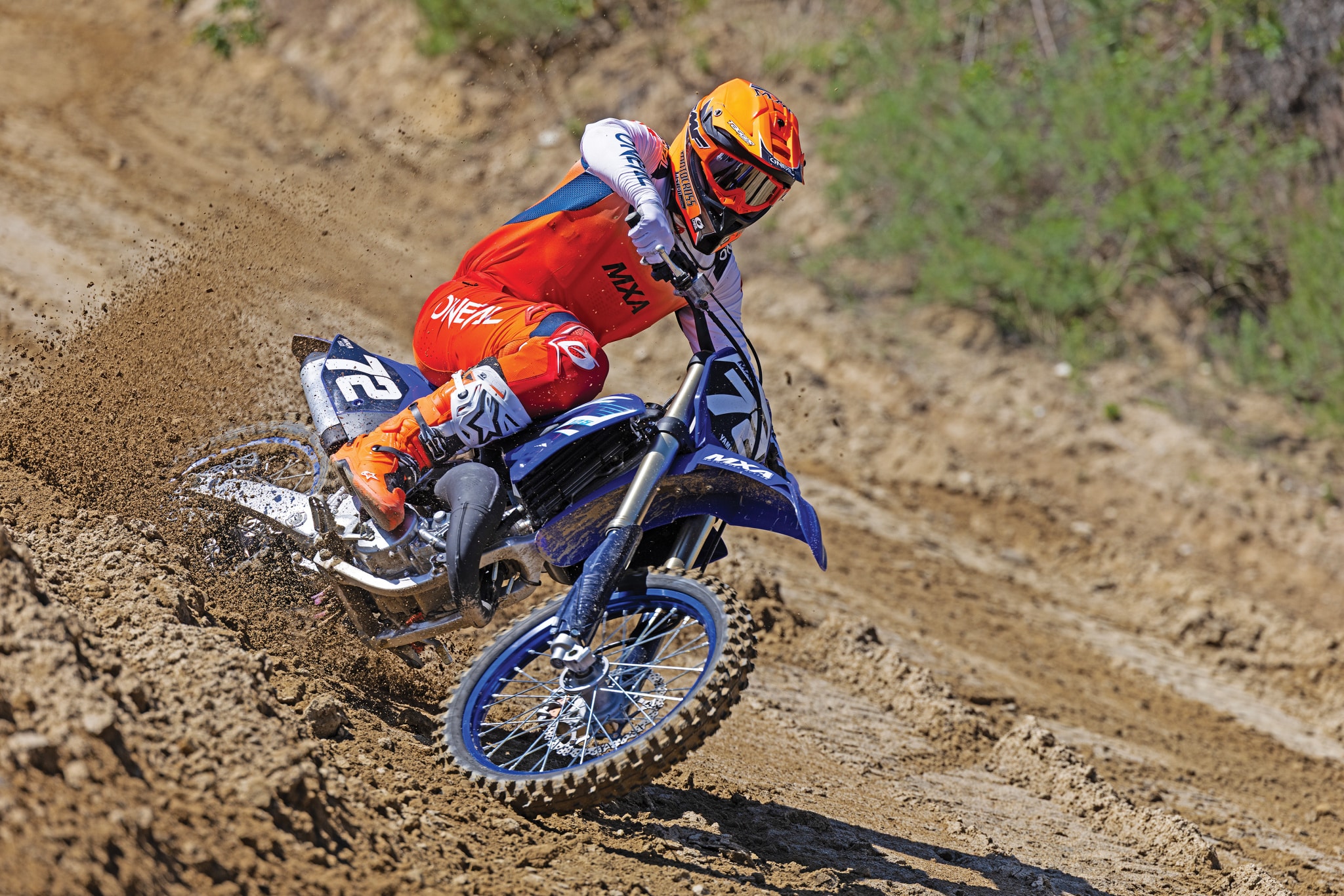 The 2025 YZ125 is extremely fun to ride, and if you are looking for where the YZ125 has a clear-cut edge over the KTM, look no further than the sticker price.
The 2025 YZ125 is extremely fun to ride, and if you are looking for where the YZ125 has a clear-cut edge over the KTM, look no further than the sticker price.
Q: WHAT ABOUT THE JETTING?
A: The latest YZ125 engine took some time for the aftermarket to figure out, and now there are plenty of upgrades available for it. As mentioned, the YZ125 switched from Mikuni to the same Keihin PWK carburetor that the YZ250 uses, but the jetting wasn’t perfect initially. We recommend a 162 main jet, 72 pilot jet, NYDF needle, clip at the first line from the top and air screw at 3-1/2 turns out.
Q: HOW FAST IS THE 2025 YZ125?
A: Yamaha YZ125 stayed the same for so long (2006–2021) that we gave up on asking for updates and shifted our mindset to being content that Yamaha was still willing to make 125 two-strokes. After all, it wasn’t such a bad gig. The YZ125 has consistently been the most fun bike to ride in the MXA stables; however, when Yamaha announced an all-new engine for 2022, we got greedy and expected a full-race 125 that would take down KTM. Unfortunately, the dyno showed that Yamaha’s new engine was only 1 horsepower stronger than before in the midrange, and it revealed that the new Yamaha engine was actually slower off the crack of the throttle all the way up to 7500 rpm than the previous YZ125 engine, which ran for over a decade.
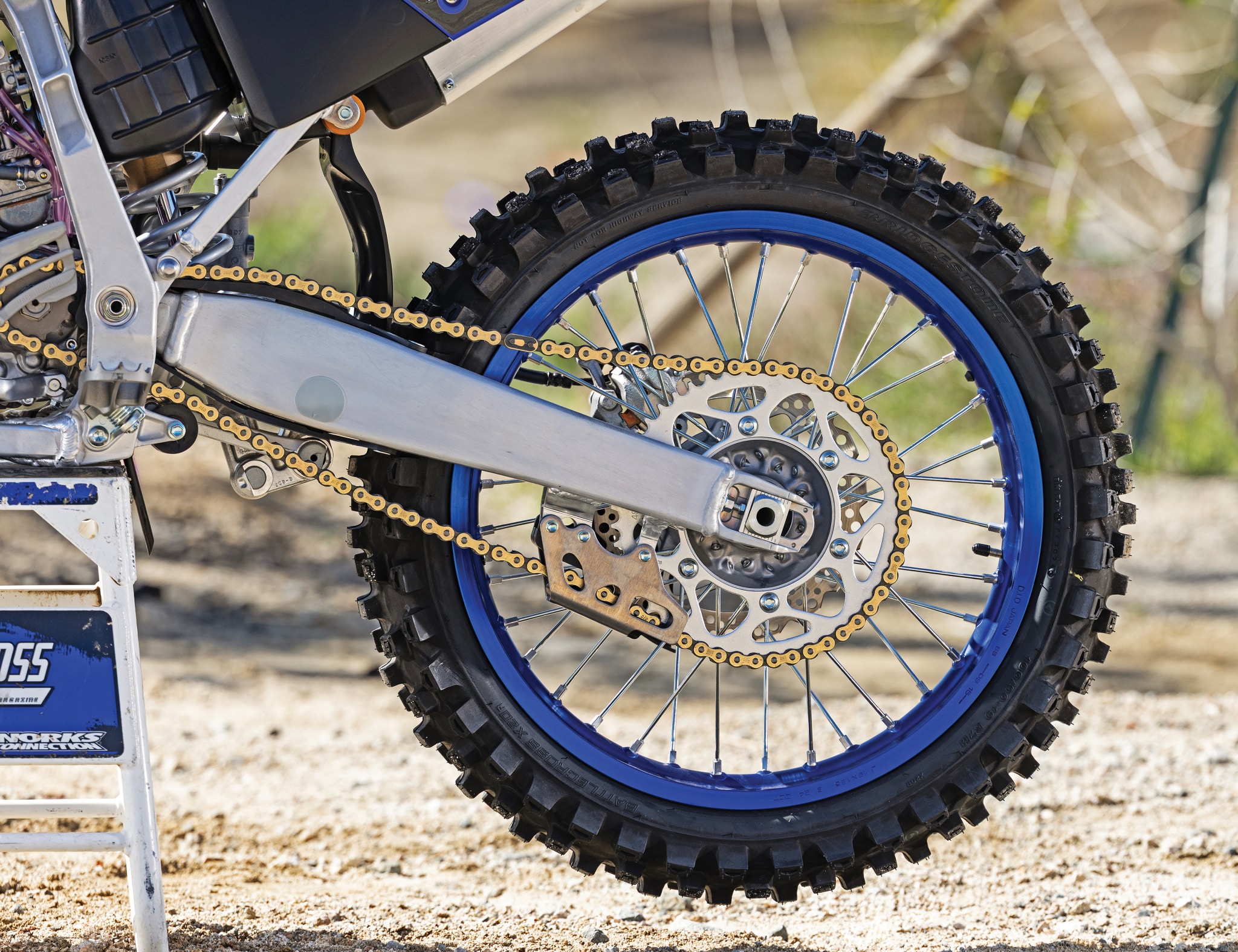 To help the YZ125 get up to speed quicker, we added a tooth to the rear sprocket, going from a 13/48 to a 13/49 sprocket combination.
To help the YZ125 get up to speed quicker, we added a tooth to the rear sprocket, going from a 13/48 to a 13/49 sprocket combination.
Q: WHAT ABOUT THE GEARING?
A: To help the YZ125 get up to speed quicker, we added a tooth to the rear sprocket, going from a 13/48 to a 13/49 sprocket combination. Yamaha also increased the Kayaba spring rates, going from 4.2 to 4.3 in the forks and 4.6 to 4.8 on the shock. The valving has been made stiffer, too. Plus, the new subframe and seat from 2024 created a flatter topography of the bike with a taller seat height. The stiffer suspension and new bodywork made the YZ125 feel racier; however, our faster and heavier test riders still complained that the suspension was too soft.
Q: HOW DOES IT HANDLE?
A: On the track, the YZ125 is still a blast to ride. Although it’s not quite as easy to exit corners as it was before, the YZ125 still gets up and goes. It requires less clutch to light up the rear wheel than the GasGas MC125. Our test riders had fun on the YZ, and many of them thought they were faster and more competitive on this bike until they started actually racing and/or noting lap times. In terms of the fun factor, the YZ125 is a 10, but when the gate drops, the power difference is really clear. If you were racing against a class of YZ125 riders only, you’d be in heaven, but there’s only one race we know of where that is the case, and it’s the bLU cRU YZ125 Cup in Europe. It is a class developed for young Yamaha riders racing in different events across Europe. The goal is to qualify for the YZ SuperFinale where the racers battle for a chance to receive a master class in training from top Yamaha MXGP riders and earn Yamaha support for the following season—pretty cool!
MXA WAS BLOWN AWAY THAT YAMAHA HAD SPENT REAL R&D DOLLARS
ON UPDATING THE YZ125 TWO-STROKE. WE EXPECTED THE FIRST ALL-NEW YZ125 IN 16 YEARS TO BE A KTM KILLER.
Q: WHAT DO WE REALLY THINK?
A: The 2025 Yamaha YZ125’s biggest flaw is that it’s not fast enough to keep up with the high-strung, high-rpm 2025 Austrian trio. Yes, you can spend money to beef up the YZ125 engine, but the KTM, Husky and GasGas riders can easily do the same to stay ahead. The 2025 YZ125 is extremely fun to ride, and if you are looking for where the YZ125 has a clear-cut edge over the KTM, look no further than the sticker price. The 2025 Yamaha YZ125 retails for $7099, which is $1100 less expensive than the 2025 KTM 125SX—that price difference could buy a lot of fuel, pistons and clutch plates for the YZ125 owner.
2025 YAMAHA YZ250
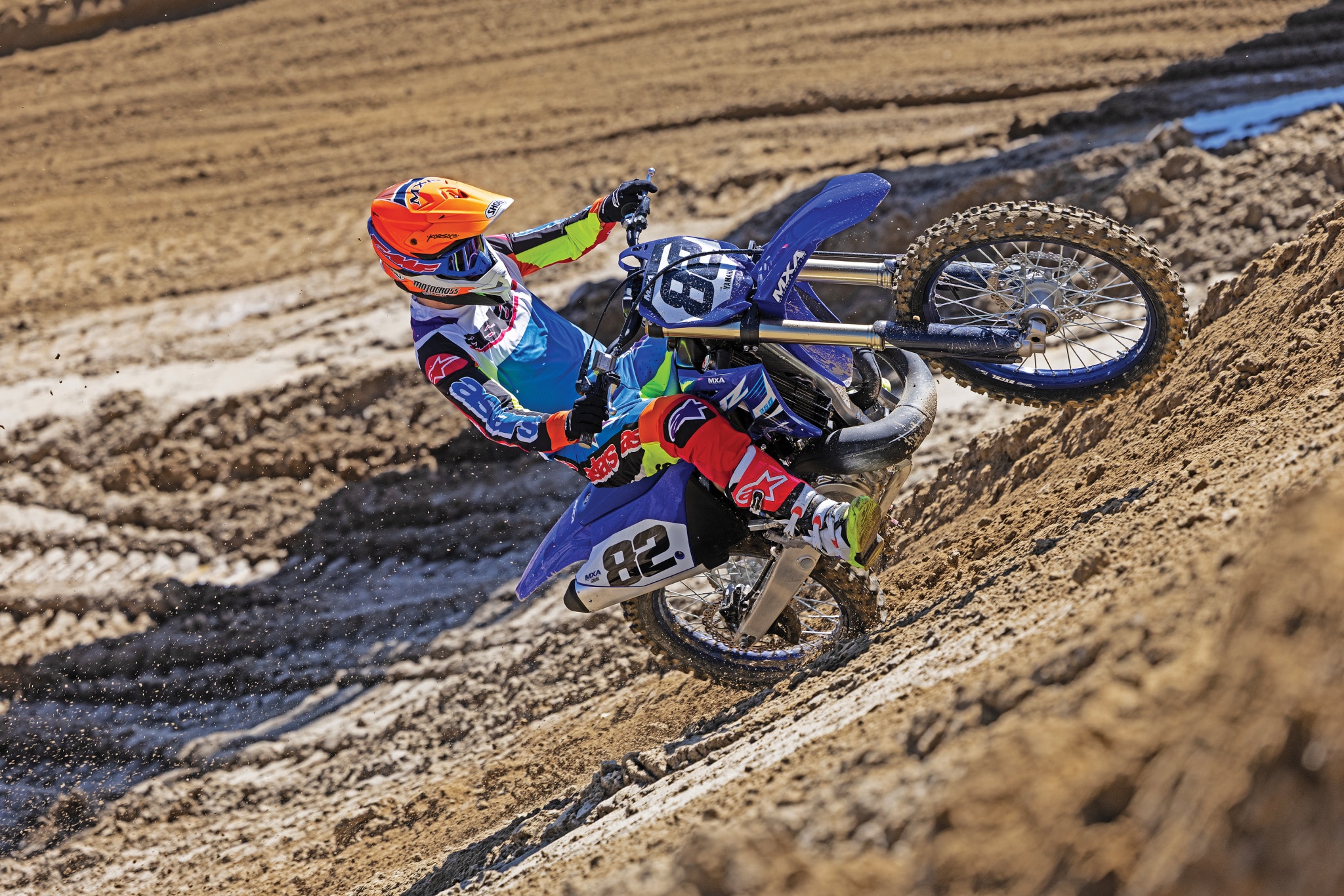 The Yamaha YZ250 and KTM 250SX remain in a stalemate. The YZ250 isn’t as powerful from low to mid as the KTM, but it makes up for that from the midrange and up.
The Yamaha YZ250 and KTM 250SX remain in a stalemate. The YZ250 isn’t as powerful from low to mid as the KTM, but it makes up for that from the midrange and up.
Q: FIRST AND FOREMOST, IS THE 2025 YAMAHA YZ250 BETTER THAN THE 2024 YZ250?
A: No. Its performance is the same.
Q: HOW ARE THE NEW YZ ERGONOMICS?
A: The bodywork and ergonomic advancements were borrowed from the 2023–2025 Yamaha YZ450F. The big bike’s spec sheet notes that the YZ450F radiator shrouds are 50mm narrower, the fuel tank is 6mm narrower, the seat is 5mm taller, and the footpegs are 5mm farther back and 5mm lower.
Q: HOW DOES THE YAMAHA YZ250 RUN ON THE TRACK?
A: The Yamaha YZ250 two-stroke is known for being smooth and manageable, while its major competition (KTM) features aggressive hit and considerably more torque and midrange power. Tailored more for racing than trail riding, the KTM 250SX hits hard, revs fast and signs off early. On low-to-mid thrust, the KTM displays a much more race-ready amount of power
If Yamaha wanted to engage in a horsepower war with the Austrian bike, they would have no choice but to pursue KTM’s stronger pull from idle to the middle, but going all out to match the KTM 250SX would be a mistake. The Yamaha’s strength lies in its friendlier powerband.
Q: WHAT IS THE TRUE-TO-LIFE YZ250 VERSUS 250SX MATCH-UP?
A: In short, Yamaha and KTM remain in a stalemate. The YZ250 isn’t as powerful from low-to-mid as the KTM, but it is easier to keep in the meat of its mid-and-up rpm range. The KTM 250SX has a strong engine, but thanks to its new fuel-injection system, you won’t want to stray far away from stock. We put a pipe and a new map from Twisted on our KTM 250SX, but that’s it. If you want a two-stroke that’s fun to ride and fun to tune, the YZ250 is your machine. If you want the electronic bells and whistles, the new-generation KTM has them.
Q: HOW DOES THE YAMAHA YZ250 HANDLE?
A: Lately, we have noticed a propensity for product planners, trying to seek the approval of intermediates and pro riders, to go stiffer on the valving and spring rates. If you are an intermediate or pro, this is a good thing, but it’s vice versa for the novices, vets and play riders. Luckily, the Kayaba forks just need a couple of clicks out on compression to make them fit the whole skill range.
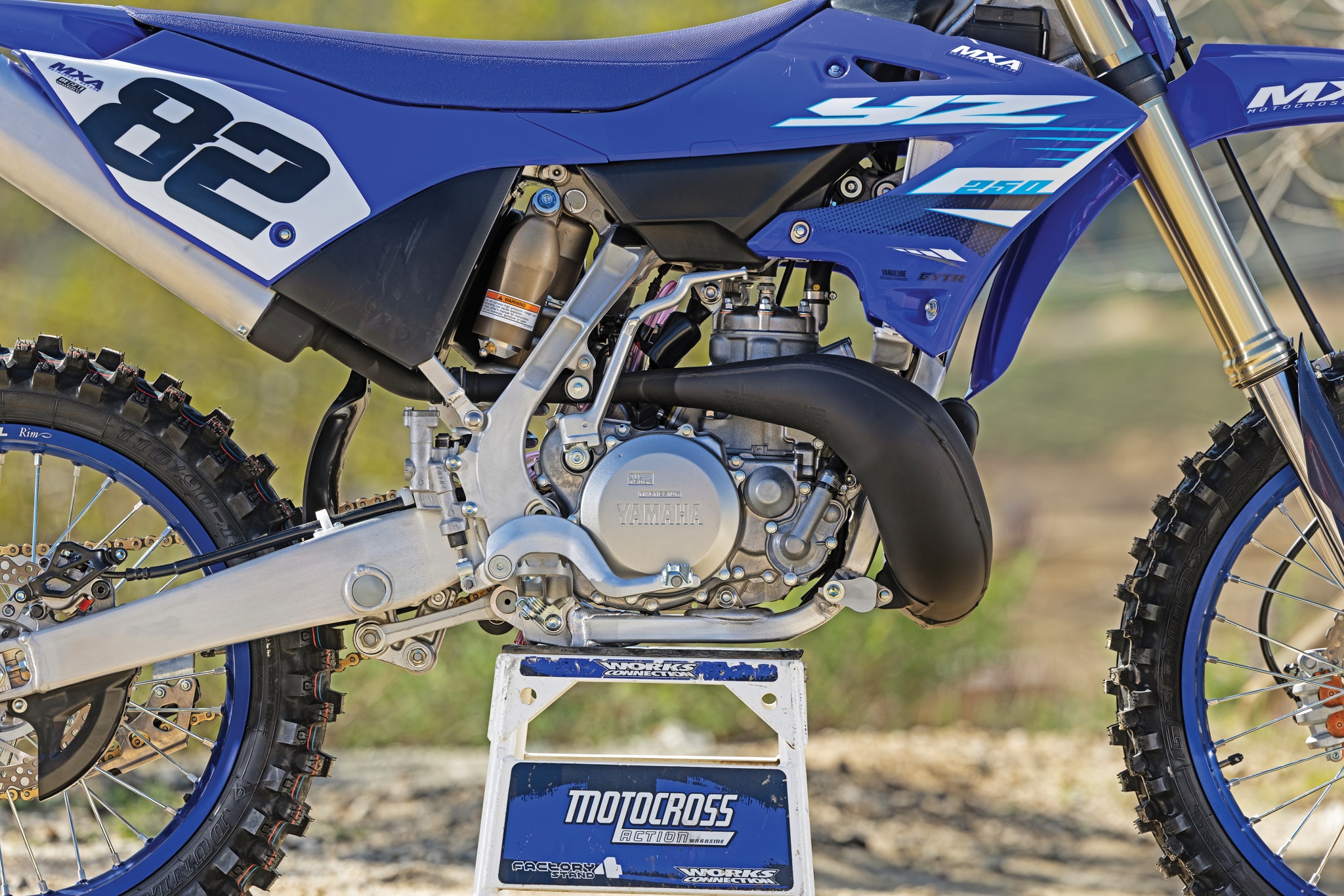 Power-wise, the 2025 YZ250 isn’t much faster than it was last year, but the fact that it can still run with the fuel-injected 2025 KTM 250SX proves how good the YZ250’s genes are.
Power-wise, the 2025 YZ250 isn’t much faster than it was last year, but the fact that it can still run with the fuel-injected 2025 KTM 250SX proves how good the YZ250’s genes are.
Q: WHAT DID WE HATE?
A: Here’s a list of things we hated.
(1) Suspension. It’s nice that Yamaha tailored the suspension settings to favor heavier and faster riders, because modern tracks are little more than jumps strung together.
(2) Seat height. Yes, we liked that we could move around easier on the new seat and bodywork, but that did not include shorter riders, who found the taller 2025 seat to be a nuisance.
(3) Wheels. Yamaha four-stroke and two-stroke wheels are not interchangeable. This is a bummer for two groups of riders: First, riders who own a YZ450F and a YZ250 two-stroke. They can’t use the wheels off one bike on the other in a pinch. Second, riders who like to run aftermarket wheels on their YZ250 and YZ-F four-strokes are forced to choose which bike to get spare wheels for. This really isn’t so much a wheel-related issue as it is the fault of the YZ250’s old-fashioned swingarm, which was built for smaller 22mm axles decades ago.
Q: WHAT DID WE LIKE?
A: Here’s a list of things we liked.
(1) Maintenance. MXA has never believed that two-strokes are more reliable than four-strokes, but we have always believed that when engine trouble rears its ugly head, two-stroke parts are four times cheaper. The YZ250 engine is the easiest modern motocross engine to rebuild.
(2) Seat. The new seat comes off with one 8mm bolt that’s covered by a plastic cap and is located unobtrusively in the rear of the seat—nice!
(3) Price. At $7999, that is $1350 cheaper than the 2025 KTM 250SX.
Q: WHAT DO WE REALLY THINK?
A: Yes, the YZ250 got a much-needed face lift. The new look and sleekness of the bodywork are cleaner and more user-friendly. On the downside, the ineffective engine upgrade means that, power-wise, the new YZ250 isn’t much faster than it was last year. The fact that it can still run with the all-new, fuel-injected, electronic-power-valve, electric-start, hydraulic-clutch, Brembo-braked 2025 KTM 250SX proves how good the YZ250’s genes are.


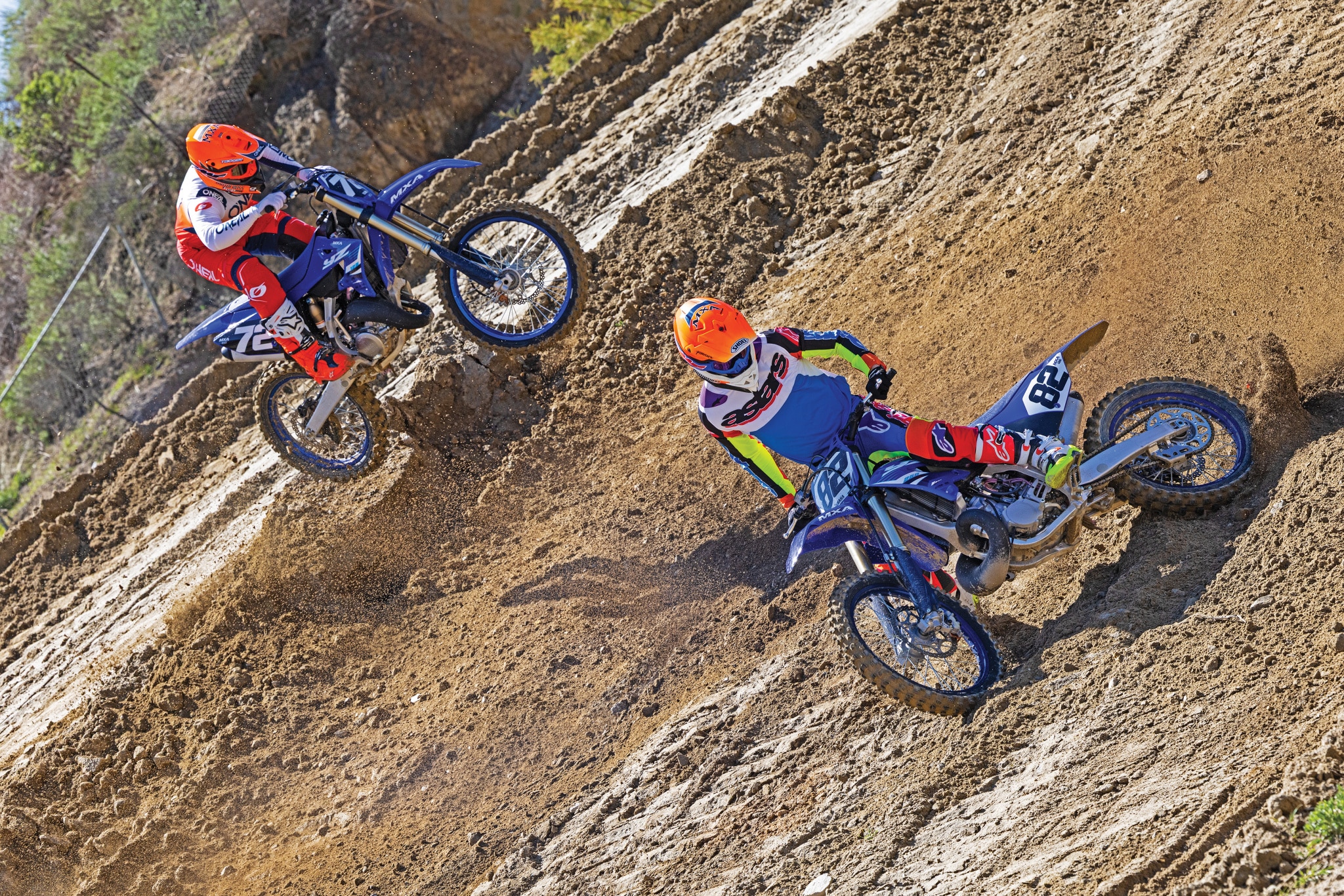


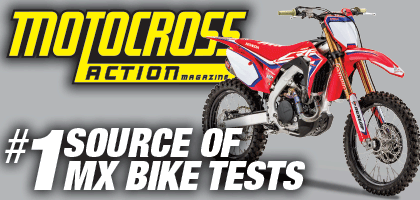


Comments are closed.